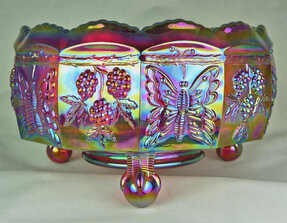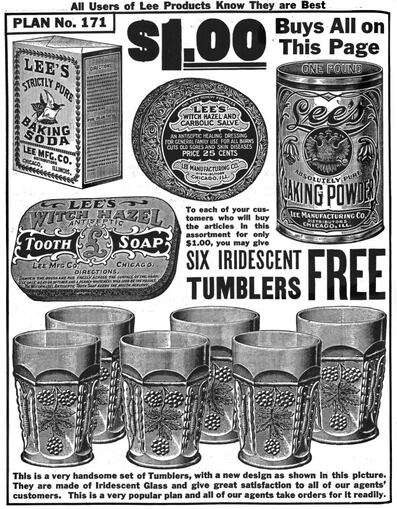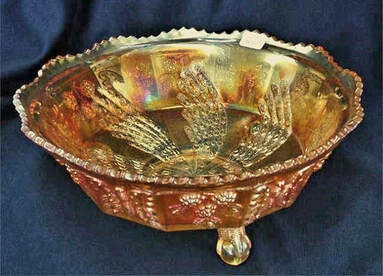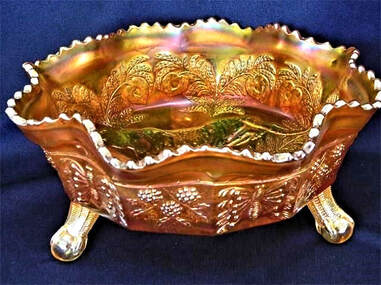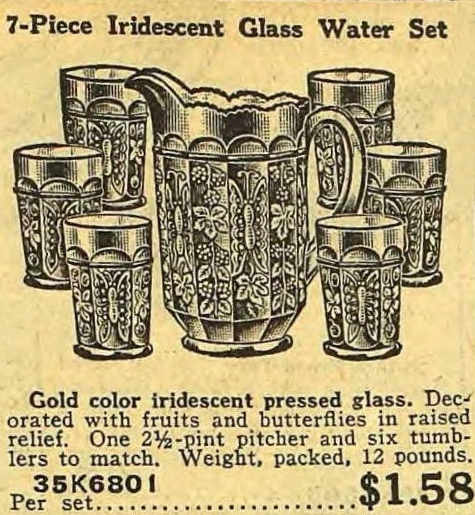The Enduring Butterfly and Berry
Copyright Glen and Stephen Thistlewood, March 2022
Fenton's Butterfly and Berry pattern had one of the longest Carnival Glass production runs that we know of - being made initially by Fenton in Classic Carnival for almost 30 years, then again by Fenton in their Revival era Carnival, and also being reproduced by an unknown maker in Korea!
Could Fenton have expected such an enduring and popular appeal when they introduced their Butterfly and Berry pattern in around 1910-11 as their pattern number "Eleven Twenty-Four"?
Left to right: a covered butter in blue (Classic Carnival), a marigold berry set, Seeck Auctions (Classic),
and a red fernery (Revival era from 1984, a HOACGA club commemorative item).
and a red fernery (Revival era from 1984, a HOACGA club commemorative item).
Classic Carnival Production
You will find Classic Butterfly and Berry in a variety of shapes: table sets (covered butter, covered sugar, creamer and spooner), water sets (pitcher and tumbler), hatpin holder, differently shaped large and small footed bowls, and even a swung vase. The pattern was used on its own as an exterior pattern, as both an exterior and interior pattern combination, and as an exterior pattern paired up with other interior patterns (Hearts and Trees, Fantail, and Panther).
|
Above is a blue Butterfly and Berry hatpin holder, one of the few Classic Carnival patterns made in this shape (see our NetworK ezine Issue #82). Picture courtesy of Burns Auctions.
The pictures, centre and right, all courtesy of Seeck Auctions, show the versatility of glass making moulds in the hands of skilled glassmakers at Fenton. In the centre are two Butterfly and Berry vases, made using the tumbler mould. After being removed from the mould, the tumbler shape was swung (whilst the glass was still malleable), so that it stretched out. In doing so, the pattern becomes very hard to discern. Further hand finishing created very different looking vases - the top one in green has a fluted top, and the bottom one in amethyst has a crimped top. |
Above, on the right, you can clearly see the different shapes that were created from the 3-footed master berry mould - the top one in green has a tightly crimped top edge; the one in the middle, in amethyst has been cupped in to create a fernery shape; the bottom one, in amethyst with a yellow iridescence has been flattened out into what is called a centrepiece shape.
Above, on the right, you can clearly see the different shapes that were created from the 3-footed master berry mould - the top one in green has a tightly crimped top edge; the one in the middle, in amethyst has been cupped in to create a fernery shape; the bottom one, in amethyst with a yellow iridescence has been flattened out into what is called a centrepiece shape.
Catalogues and Ads, 1911 to 1925
Shown below is an ad from the 1911 Butler Brothers Mid-Spring wholesale catalogue (*). As far as we know, it was the first time that Butterfly and Berry items appeared there. In the same year, tumblers also appeared in the Lee Manufacturing Company Mail Order catalogue (below, right).
|
Above: Butler Brothers Mid-Spring 1911
Below: a marigold Butterfly and Berry table set, courtesy Burns Auctions. |
Above: Lee Manufacturing, 1911, courtesy of Lance Hilkene.
Six FREE tumblers for spending $1 on the other products in this Plan No. 171. How did they do that? Well, the wholesale price from Butler Brothers was 62 cents for 22 pieces in a set, which is an average of less than 3 cents each. So the 6 "free" tumblers would actually have cost Lee Manufacturing 18 cents at most, leaving plenty of profit margin on the other 4 items in the Plan. |
The next year, 1912, Butterfly and Berry appears in the Butler Brothers April catalogue in a Fenton assortment - the C1617 "MONARCH" Assortment. We also see the exterior Butterfly and Berry pattern matched with a different interior pattern, which is Fantail, in the C2168 "GIANT" Fruit Bowl Assortment.
|
Above: a Butterfly and Berry tumbler in this assortment, which also included Cherry Chain bowls, a Holly comport and hat shape, a Panelled Diamond and Bows vase, an Orange Tree footed berry and a Blackberry Banded hat shape. Note how 9 items are shown but 12 are described; this was not uncommon, giving Butler Brothers flexibility in what was shipped to buyers.
Moving onto 1913, and we can see how the Fenton designers and their mouldmakers had really developed their creative flair in the range and style of patterns that were being produced. This Butler Brothers ad was in April. The C2413 "AURORA" Assortment was resplendent with images of flora and fauna; grapes, stylised and realistic flowers, stags, peacocks, panthers and even dragons! And of course, Butterfly and Berry was there, in the form of a pitcher and tumbler, and as an exterior pattern on the Panther master and small berry bowls. Above: a Butler Brothers ad from April 1913.
A spectacular Panther centrepiece bowl in blue.
|
Above: in the centre is a Butterfly and Berry master berry (interior and exterior pattern) and on the right is a Fantail bowl with Butterfly and Berry exterior. The pattern on the left is Cherry Chain.
Above: a large marigold Fantail bowl with Butterfly and Berry exterior.
Below: a Panther master berry bowl with Butterfly and Berry exterior. Both pictures courtesy Seeck Auctions.These pieces are also found where the top has been flared out into what is called a centrepiece bowl shape. The Panther pattern is a brilliant design, shown to best effect on the unruffled centrepiece bowl shape, shown left in blue. We have a major feature article on this design, which is actually a Persian Tiger (aka Caspian Tiger). Here is the link: Carnival Glass Times - Panther
Above: the two sizes of Panther berry bowls (master and small berry) in marigold. Courtesy Seeck Auctions.
|
The C2413 "AURORA" Assortment continued to be offered from 1914 to 1918 (with some small changes, mainly price-related). Then, from 1918 right through to 1924, it was replaced with the C2414 "NEW AURORA" Assortment. Although fewer pieces were illustrated in the "New Aurora", the items sold in the actual assortment seems to be virtually the same as the "old" Aurora. Alongside the "New Aurora", Butler Brothers offered the C2402 "MAGNET" Assortment from 1917 to 1923.
|
The C2402 "MAGNET" Assortment in Butler Brothers, June 1917.
|
Only one item with the Butterfly and Berry pattern appeared in the "MAGNET" Assortment - as an exterior pattern on the Panther berry. There may have been other Butterfly and Berry items in this assortment, because (as before) Butler brothers did not illustrate all the pieces in this offer. The pieces illustrated in the ad on the left are: Top row, left to right - Wine and Roses goblet, Diamond and Rib vase, Orange Tree mug, Lattice and Grape tumbler, Panther berry. |
|
Naturally, for such a popular pattern, Butterfly and Berry continued to be on offer through various mail order and retail outlets. Shown below is an extract from a 1920 Montgomery Ward catalogue, which had several selections of this pattern for sale. The mark-up in price between the wholesale price in Butler Brothers and the mail order retail price appears to be at least 100%, and it is always possible that Montgomery Ward bought even more cheaply and/or in volume, directly from Fenton. Montgomery Ward 1920
Also, as we have reported elsewhere on our website, Fenton glass was exported around the world, with Europe and Australia being important markets for them. On the right is a 1922 catalogue from Foy and Gibson Pty. Ltd. in Australia, and yes we see that Butterfly and Berry was included. The ad illustrated the small berry/sauce, described as a "Sweet Dish". It's interesting that Foy used the same "AURORA" marketing term as Butler Brothers. In fact, Aurora has an interesting history as descriptive "marketing speak" for iridescent glass, and we have the full story here: Aurora Marketing Speak! |
Foy and Gibson, Australia, 1922
|
Into the mid and late 1920s, the USA consumer appeal for Carnival Glass was on the decline, and with it the US glassmakers turned their production to other types of glassware. Nevertheless, Butterfly and Berry seemed to retain its attraction, and we see various ads for it, with water sets, table sets and berry sets being the main focus.
Whilst Butterfly and Berry has had its day in Classic Carnival Glass, it was by no means the end of this extremely popular and versatile pattern. When Fenton decided to make Carnival Glass in the Revival Era, it is probably not surprising that one of the patterns they turned to was Butterfly and Berry.
Butterfly and Berry in Revival Carnival
In the 1970s, Fenton started making Carnival Glass again, often using their original moulds and also a massive range of entirely new innovative patterns and shapes. Their Revival Carnival production was clearly marked, as we cover extensively in "Fenton Old and New".
In the 1970s, Fenton started making Carnival Glass again, often using their original moulds and also a massive range of entirely new innovative patterns and shapes. Their Revival Carnival production was clearly marked, as we cover extensively in "Fenton Old and New".
|
The Butterfly and Berry tumbler mould proved to be very versatile in the hands of Fenton's skilled glassmakers producing Revival Carnival.
Fenton's Butterfly and Berry tumbler mould.
Courtesy of the Fenton Family and Fenton Art Glass Company. Using the tumbler mould, Fenton made a wide variety of Butterfly and Berry items in aqua opal for Gary Levi / Levay Glass. A wide variety of hand-finished shapes were made, by combinations of top shaping, crimping and applying handles. Images below (centre and right) courtesy Seeck Auctions. |
|
|
Another Butterfly and Berry mould that was re-used in the Revival Era Carnival production was the footed master berry bowl mould, shown below, courtesy of the Fenton Family and Fenton Art Glass Company. |
Above is an extract from a Fenton catalogue. It shows the Revival Butterfly and Berry master berry exterior pattern, being used with Fantail interior pattern (the same combination that was used by Fenton in Classic Carnival). The colour was called "teal marigold", colour code OI, introduced in 1988-89. Below is another example of the Butterfly and Berry / Fantail combination in purple, courtesy of Burns Auctions.
|
Butterfly and Berry Fakes
Perhaps as a sad reflection on the enduring popularity of the Butterfly and Berry pattern, fake versions of the large 3-footed bowl began to appear, being first reported in the 1980s. They were (and possibly still are) being made in Korea.
Perhaps as a sad reflection on the enduring popularity of the Butterfly and Berry pattern, fake versions of the large 3-footed bowl began to appear, being first reported in the 1980s. They were (and possibly still are) being made in Korea.
|
They are made from a new mould (copying the Fenton original), and the interior pattern on the fake is more concentrated in the centre of the bowls (see below, right). They are known in blue, light pink, amethyst/black amethyst/purple, and a milky white opalescent-looking colour, advertised as "White Opal Iridescence", which is not to be confused with the fairly rare Classic Carnival pieces in white. Two of the colours of the Korean made fake Butterfly and Berry 3-footed bowls.
Left "White Opal Iridescence", courtesy of Hb Lammers. Centre and right, black amethyst, courtesy of Tony Meyer. |
|
Thanks to research into these imports by the late Frank M Fenton, there is an easy and clear way to spot the genuine Fenton article and the Korean fake – look at the large, central butterfly on the inside of the bowl. On the genuine Fenton pieces there are 6 dots on each side of both wings. On the Korean fake there are only 5 dots on each side (the bottom dot is missing). Note that this applies only to the central butterfly on the interior of the 8-9 inch sized bowl – the butterflies encircling the exterior are different and are copied better. See the sketch on the right, by Glen Thistlewood, which clearly illustrates the difference. There are many other small pattern differences between the fake and the original, but this is an easy “tell”. |
Sketch of the butterfly in the centre of the large berry bowl.
There are six dots on the wings of the Fenton originals, but only five dots on the wings of the fakes. |
Further reading
* Extracts from Butler Brothers catalogues are thanks to San Diego County and Southern California Carnival Glass Clubs.


